Graph structure, another approach
data Node a = Node a [Node a]
data Graph a = Graph [Node a]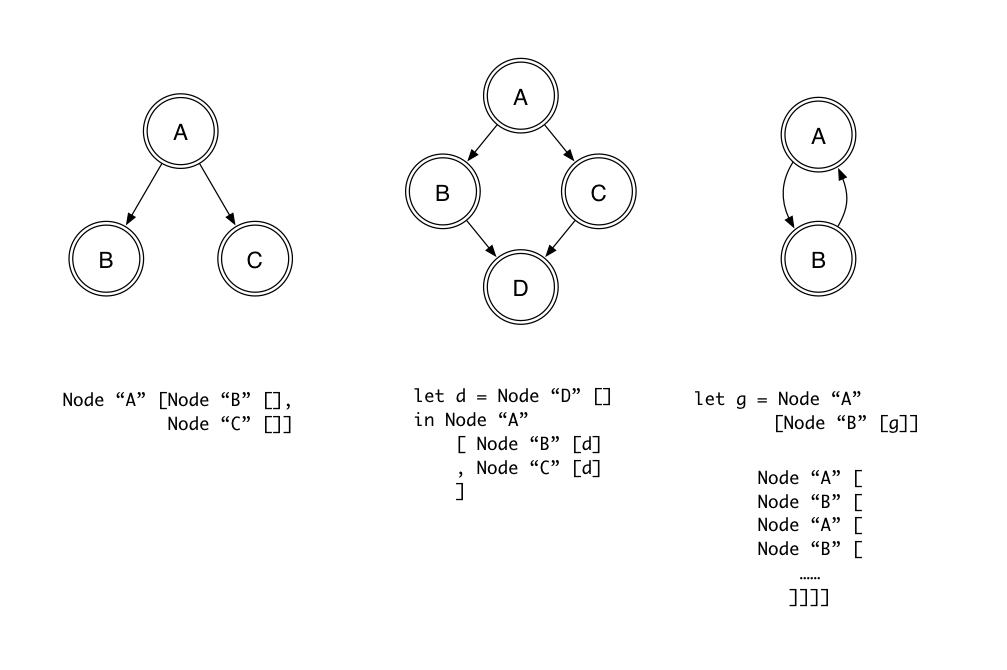
Ivan Veselov
June 14, 2014
Motivation
Graph representation options
Inductive graphs
Representing graph structure
Representing typical graph algorithms
Represent nodes as ints, edges as pairs
Corresponds to usual definition of the graph as two sets
data Graph = Graph
{ nodes :: [Int]
, edges :: [(Int, Int)]
}
g1 = Graph
{ nodes = [1,2]
, edges = [(1,2), (2,1)]
}Easy to represent cycles.
data Node a = Node a [Node a]
data Graph a = Graph [Node a]
Not so fast. Cycles are tricky. Sharing is tricky.
We can represent DAGs using sharing, but this sharing is not observable.
We can represent cycles using Haskell laziness and "tying the knot" technique, but it is fragile.
First intuitive idea: mimicking imperative graph algorithms
Imperative algorithms usually maintain additional data structure (e.g. to mark visited nodes)
Can we do better?
Introduced in "Inductive graphs. Functional graph algorithms" paper by Martin Erwig.
Limitations of previous approaches are caused by monolotic representation of graphs. The algorithms are bulky and need to keep track additional information regarding to traversal.
Algorithms on lists and trees are elegant and easy to reason about.
Inductive graphs: an inductive data structure with two constructors similar to lists or trees.
Profit: we can use pattern matching and immediately express and reason about simple algorithms (reversing the edges, calculating nodes, etc.).
This idea has been implemented in "fgl" library by Martin Erwig included in Haskell platform. FGL = functional graph library.
type Node = Int
type Adj e = [(e, Node)]
type Context v e = (Adj e, Node, v, Adj e)
data Graph v e
= Empty
| Context v e :&: Graph v eAkin to lists we either have an empty graph or an extension of the graph with a context
Context v e: v and e are types for labels (for vertices and edges)
Context represents a node, its label and its inbound and outbound edges
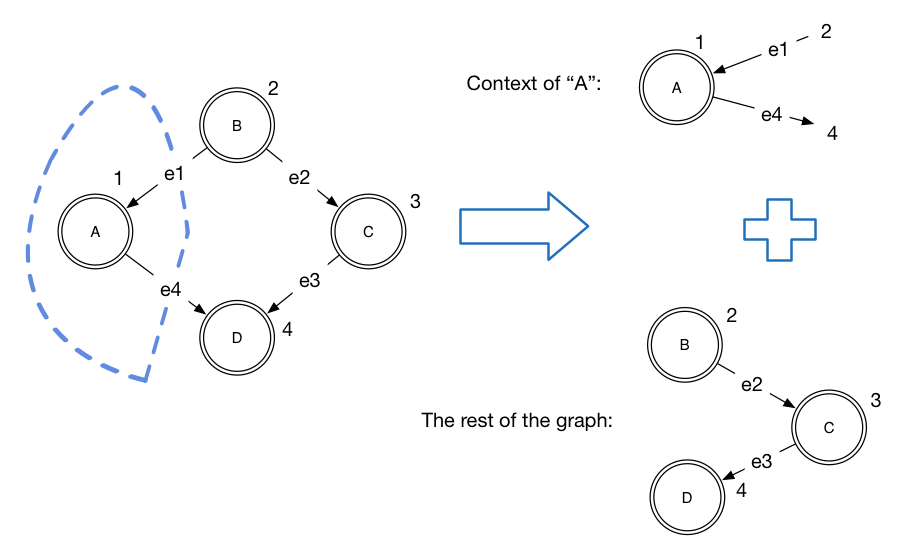
context of node 1 = ([(2, "e1")], 1, "A", [(4, "e4")])
([("left", 2), ("up", 3)], 1, 'a', [("right", 2)])
&
([], 2, 'b', [("down", 3)])
&
([], 3, 'c', [])
&
EmptyisEmpty :: Graph v e -> Bool
isEmpty Empty = True
isEmpty _ = False
gmap :: (Context v1 e1 -> Context v2 e2) -> Graph v1 e1 -> Graph v2 e2
gmap _f Empty = Empty
gmap f (c :&: g) = f c :&: gmap f g
grev :: Graph v e -> Graph v e
grev = gmap swap where swap (i, n, v, o) = (o, n, v, i)grev (grev g) = g
gmap f . gmap g = gmap (f . g) (1)
swap . swap = id (2)ufold :: (Context v e -> acc -> acc) -> acc -> Graph v e -> acc
ufold _ acc Empty = acc
ufold f acc (c :&: g) = f c (ufold f acc g)
gmap = ufold (\c -> (f c :&:)) Empty
nodes :: Graph v e -> [Node]
nodes = ufold (\(_,v,_,_) -> (v:)) []
undir :: Graph v e -> Graph v e
undir = gmap (\(p,v,l,s) -> let ps = nub (p ++ s) in (ps,v,l,ps))For efficiency reasons Graph is an abstract type, so we have to use a smart constructor (&) instead of constructor (:&:)
To facilitate this we have the following functions:
isEmpty :: Graph v e -> Bool
-- matchAny extracts any context from the graph
matchAny :: Graph v e -> (Context v e, Graph v e)
-- unordered graph handling idiom
gmap f g | isEmpty g = g
| otherwise = f c & (gmap f g')
where (c, g') = matchAny g-- match decomposes a graph into a context for particular node and the rest of the graph
match :: Node -> Graph v e -> (Maybe (Context v e), Graph v e)
-- usage example
f v g = case match v g of
(Nothing, g') -> e1
(Just c, g') -> e2
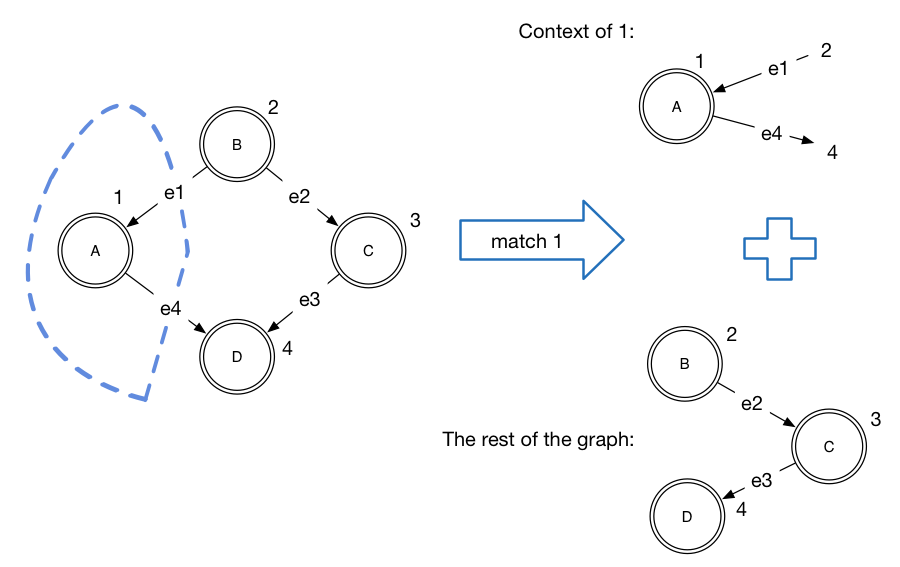
Depth first search: useful algorithm which is a base for many other algorithms (topological sort, SCC, etc.)
Idea: visit each node in a graph once by visiting successors before siblings.
Input: we provide a list of nodes, it is needed if graph contains several components.
Output: a list of nodes in traversal order.
dfs :: [Node] -> Graph v e -> [Node]
dfs [] _ = []
dfs (v:vs) g = case match v g of
(Just c, g') = v : dfs (suc c ++ vs) g'
(Nothing, g') -> dfs vs g'match to avoid visiting the same node more than once. When context of the node is matched, we return the rest of the graph which does not contain this node anymore.dfs :: [Node] -> Graph v e -> [Node]
dfs [] _ = []
dfs (v:vs) g = case match v g of
(Just c, g') = v : dfs (suc c ++ vs) g'
(Nothing, g') -> dfs vs g'bfs :: [Node] -> Graph v e -> [Node]
bfs [] _ = []
bfs (v:vs) g = case match v g of
(Just c, g') = v : bfs (vs ++ suc c) g'
(Nothing, g') -> bfs vs g'bfs :: [Node] -> Graph v e -> [Node]
bfs [] _ = []
bfs (v:vs) g = case match v g of
(Just c, g') -> v : bfs (vs ++ suc c) g'
(Nothing, g') -> bfs vs g'DFF = depth first search spanning forest.
DFF is a forest (list of tree) which contain nodes in the order of depth first search traversal.
DFF is used in topological sort and strongly connected components algorithms
data Tree a = Br a [Tree a]
dff :: [Node] -> Graph v e -> [Tree Node]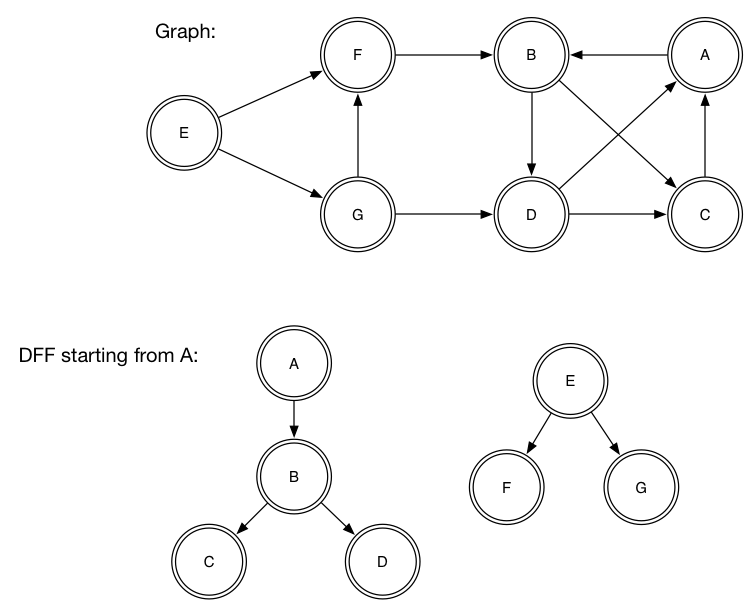
-- Toppological sort is a reversed post-order on DFS
topsort :: Graph v e -> [Node]
topsort = reverse . concatMap postOrder . dff
-- Kosaraju-Sharir algorithm for strongly connected components
scc :: Graph v e -> [Tree Node]
scc g = dff (topsort g) (grev g)There are several implementations: based on trees and Patricia trees (Data.IntMap).
We'd like to have composition and decomposition of the graph to be constant or at least sublinear.
Data.IntMap insert, delete and adjust has O(min(log n, W)) worstcase where W is number of bits in Int (32 or 64).
Composition and decomposition of the graph (& and match) are still linear in terms of the vertex degree, since we have to handle all edges.
Overall, theoretical complexity of provided implementations are not great, but according to the paper works well in practice.
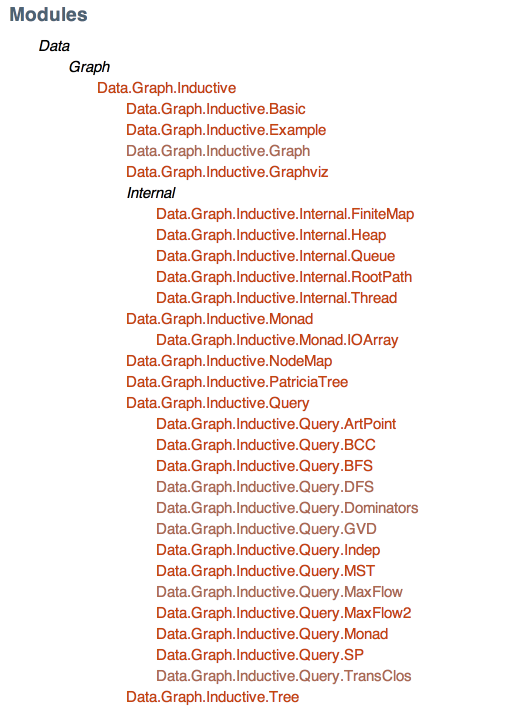
The major selling point of FGL is its API
FGL provides rich and convenient API a la algebraic data types
API facilitates expressing graph algorithms in terms of recursive definitions